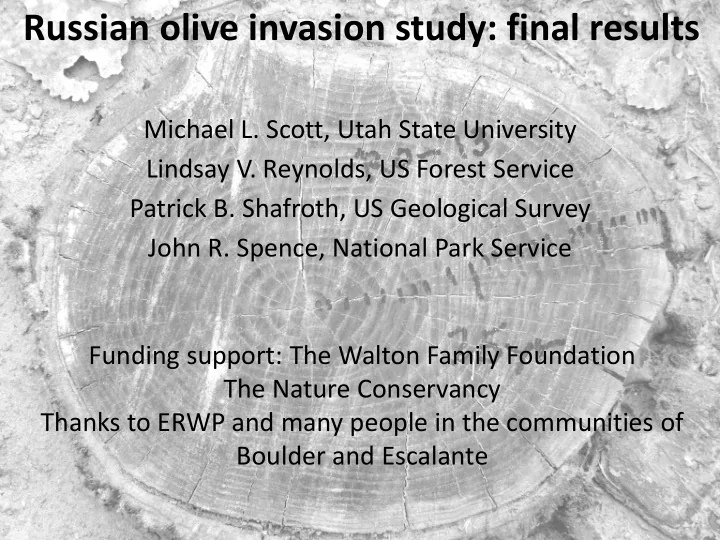

Russian olive invasion study: final results Michael L. Scott, Utah State University Lindsay V. Reynolds, US Forest Service Patrick B. Shafroth, US Geological Survey John R. Spence, National Park Service Funding support: The Walton Family Foundation The Nature Conservancy Thanks to ERWP and many people in the communities of Boulder and Escalante
Approach — field and lab • Large-scale removal began • Ring counts and in 2000 GPS locations on 735 cut stems • Geospatial analysis of aerial imagery: ’ 51( ’ 61); ’81; ‘10 >map geomorphic surfaces >estimate woody vegetation cover by surface >map Russian olive cover (‘10) >ArcGIS spatial analyses
Study area • Two study reaches; 1 in Grand Staircase-Escalante NM and 1 in Glen Canyon RA • Targeted sampling in Boulder and Escalante
Results • Channel narrowed by ~75% from 1950s to 2010 • Cottonwood cover increased up to 1981; Cw and Ro afterward
Results • ~30 yr lag in Ro establishment; rapid after 1980, later downstream • Lags common in plant invasions; reasons vary • Rapid recruitment decline; saturation of establishment sites?
Results B. Wolverton B. Wolverton • In reach 2, Ro established on low, moist channel bars, stream-ward of Cws, beginning in the early 1990s • Ros flank the channel, building levees as seen along other narrowing channels (Friedman et al. 2015)
Results • 1951: broad, active channel; Cws establish on mid-channel bars • 1981: narrowed active channel; Cws establish along channel margins • 2010: extreme channel narrowing; Cw canopies expand; Ro establish on moist channel margins and bars
Negative affects — levee construction and extreme narrowing ? > Extreme narrowing and possible down-cutting of channel
Negative effects — channel simplification > Channel simplification: less dynamic erosional and depositional processes; loss of habitat diversity for aquatic organisms
Results — interpretation of invasion
Conclusions & Questions • Narrowing began in the late 1940s – early 1950s • Russian-olive introduced/established in Boulder and Escalante in early 1950s • Extensive establishment in mid 1980s and mid 1990s; 1° spread by floods • Invasion narrows and simplifies channel • Why the 30 yr lag? Spread and reproduction of large-seeded species Favorable establishment conditions created by initial narrowing • Will channel widening following treatment improve future establishment conditions for Russian-olive?
Recommend
More recommend